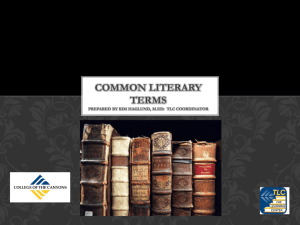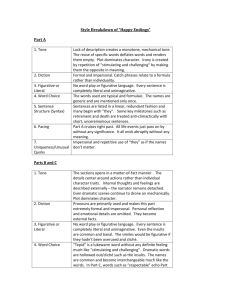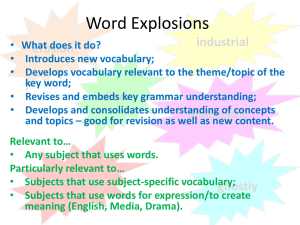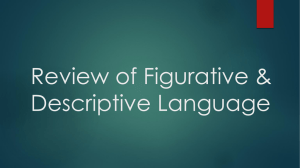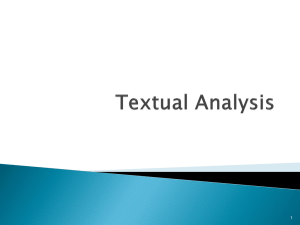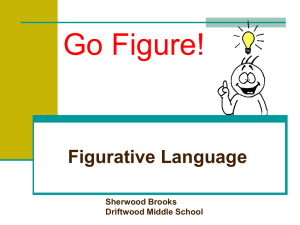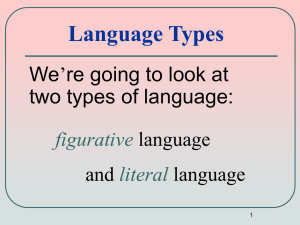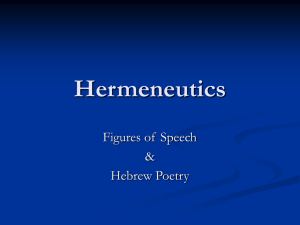Close Reading Analysis (powerpoint)
advertisement
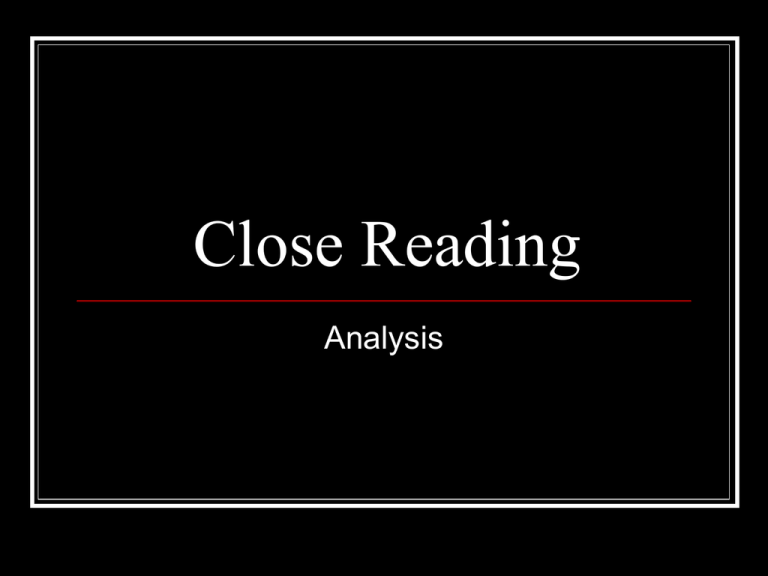
Close Reading Analysis Introduction… Analysis questions ask you to think about how a writer has expressed ideas. Make sure you focus on how a writer is writing rather than what a writer is writing. Analysis questions have “A” next to them on the question paper. The Style… Analysis questions will deal with all aspects of style. Look very carefully at the question and pick out what you need to analyse. We will look at: Structure. Language. Tone. Structure… The structure of a sentence is the way it is made up and how the elements are arranged. Important elements to look out for are: The type of sentence. How the sentence is linked or separated by punctuation. The patterns of sentence structures. Sentence Structure 1 – The type of sentence… The following slides outline the 5 types of sentences you need to be aware of. Copy down the names, definitions and reasons for using the five main types of sentence. Copy down my examples, or write your own. Sentence Structure 1 – The type of sentence… A statement John is sitting down. Statements are usually in narrative or factual writing. Sentence Structure 1 – The type of sentence… A question Is John sitting down? Questions may be used in reflective or emotive writing. Note especially, the rhetorical question. This is a question to which no answer is really expected; it may have the effect of a strong statement: What time of night do you call this? Sentence Structure 1 – The type of sentence… An exclamation John is sitting down! Exclamations are used to convey a tone of amazement, shock or strong emotion. Sentence Structure 1 – The type of sentence… A command Sit down, John. Commands are used in instructions and in writing aiming to persuade, such as advertisements. Sentence Structure 1 – The type of sentence… A minor sentence Where the verb is omitted for dramatic effect – usually, but not always, this is some form of the verb ‘to be’. For example: He looked in his rear view mirror. Nothing coming. The words ‘Nothing coming’ do make complete sense, despite the missing verb; they are more than just a phrase. This is a more concise way of saying ‘Nothing was coming.’ Minor sentences are used for various reasons: To create impact, suspense or urgency To suggest informality As abbreviations in notes and diaries Paragraphing… A new paragraph in a close reading passage usually marks a new stage in a narrative or argument. Paragraphing can be used for effect – to make something stand out or to slow the action and create suspense. Punctuation… You may be asked to comment on the use of punctuation. We all know about full-stops and question marks, but what about other types? Inverted commas: used for titles, speech, quotations and to separate some words. Colons: introduce a quotation, list or explanation. Semi-colons: can separate a list or create a finishing pause. Parenthesis: information is separated from the rest of a sentence. May be an explanation or some other kind of additional information. Sentence Patterns… Sometimes sentences are written in a certain order for effect. Inversion A sentence written in reverse. Instead of the subject coming first (Flames leapt up and up), the rest of the sentence comes first (Up and up leapt the flames). Repetition Some words are repeated to make them stand out. Climax/Anti-climax Climax: a list of words that get stronger. Anti-climax: A list of words that get weaker. Antithesis A sentence with balanced statements (You can take the boy out of Scotland, but you can’t take Scotland out the boy). Length Short or long? Why? Language… The writer's use of language is an important element of style and meaning. We need to look for: Formal vs informal language Literal / Figurative language Remember, these are analysis questions, asking how the writer writes. Formal vs Informal Language… There is a simple distinction between formal and informal language: Formal Informal Usually written No abbreviations Correct grammar and structure Spoken, or a written version of speech Uses shortened forms Grammar and structure not as important More common, everyday words used Wide range of word choice including technical and complicated words Impersonal tone – the writer does not get involved personally with the topic Factual and accurate Personal approach (use of I, we, you) May include feelings and opinions Formal vs Informal Language... Within the formal/informal split, there are other examples to be familiar with: Jargon (Formal): A special technical language associated with a certain field. Rhetorical language (Formal): Language used for effect in persuasion. Often tries to involve the reader or ask questions. “Byte”, “Icon” and “Font” are examples of computing jargon. “How can we stop trying to succeed when victory is so close?” Dialect and slang (Informal): Dialect is language used in a particular area; Slang refers to conversational, non-standard communication. “Ah hivnae got a clue whit ye're talkin' aboot” Literal / Figurative Language Literal language means words are used to mean exactly what they say. Figurative language means using figures of speech and comparisons to write more expressively and effectively. We will look at: Using comparisons Sound effects Overstating and understating Contrasts Old and New language Literal / Figurative Language Using comparisons Simile: When something is compared to something else using “like” or “as...as” Metaphor: When something is said to be something else “She cried like a baby” “His voice was as loud as a foghorn” “She was a crying baby” “His mouth was a foghorn” Personification: Giving an inanimate object human or other living qualities “The sun smiled in the sky” Literal / Figurative Language Using comparisons – how to answer: Identify the imagery: simile, metaphor or personification? Ask yourself what is being compared to what In what ways are the two things similar? How does the comparison help you to visualise the subject better? Literal / Figurative Language Sound effects: Alliteration: When several words together start with the same letter or sound. Onomatopoeia: When words imitate the sound they are describing. “The clip-clop of clogs on the cobblestones” “crash”, “bang”, “boom” Pun: A play on words which sound similar, giving a comic effect. “Waiter, what's this?” “It's bean soup, sir” “I don't care what it's been. What is it now?” Literal / Figurative Language Overstating and understating: Hyperbole: Deliberate exaggeration to emphasise something “Is there anything to drink? I'm dying of thirst!” Litotes: The opposite of hyperbole – deliberate understatement “The teacher was slightly annoyed about my lack of homework” Euphemism: A less direct and less direct way of saying something unpleasant “I have some bad news. I'm afraid your father has passed on” Circumlocution: To “talk around” something – often used by politicians to avoid answering a question! “Are you going to spend more on education, prime minister?” “The education of our young people is a government priority” Literal / Figurative Language Contrasts: Paradox: A statement that appears to be a contradiction, but on closer inspection contains a truth “To preserve the peace, prepare for war” Oxymoron: A condensed version of a paradox, with two opposites placed together “Sweet and sour” Juxtaposition: Literally means side by side. An oxymoron contains two statements in juxtaposition Literal / Figurative Language Old and New Language: Neologism: An invention of a new word, usually to describe a new development where a word does not yet exist Recent examples: “filofax” “modem” “chav” and “emo” Archaism: Language from the past, no longer in use Examples: “thou”, “thy” and “thee” Cliché: A word or phrase that has become overused Examples: “In this day and age” and “thinking outside the box” Tone... The tone of a piece of writing refers to the way in which it would be said if read aloud. The tone refers to a particular attitude or feeling conveyed by the writer. e.g. Consider the question - “Where have you been?” Discuss with a partner how this would be read out in the following situations? – - By someone welcoming their friend back from holiday – - By someone to their friend they have not seen in a while – - By a parent to a teenager who arrives home at 4am. Different tones... Serious: For important topics and passages. Within serious, the tone could be described as formal, ponderous (thoughtful), pompous (know-it-all) and even solemn (for sad pieces of writing. Humorous: For more light-hearted and comical passages. Within humorous, the tone could be described as flippant (an irreverent attitude to something normally taken seriously), conversational (chatty and friendly) and ironic (saying the opposite of what one means for comic effect) Different tones continued... Effusive: Used to persuade the reader. Emotive: To stir emotions in the reader. Typically uses hyperbole, rhetorical language and imagery. And so on...Try not to simply describe the tone as serious or humorous – use more descriptive words to describe the tone.
